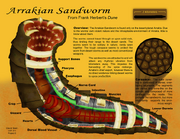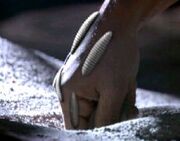Sandworms – known by the Fremen as Shai-Hulud and given the scientific name Geonemotodium arraknis[1] – are gigantic annelid-like creatures which dwell underground on planet Arrakis.
Their larval stage is known as Sandtrout.
Biology[]
These creatures can grow up to 400 meters in length (although much larger individuals have been rumored to exist), and have a three-jawed mouth filled with sharp crystalline teeth. They usually feed on large quantities of sand and sand plankton – which consists of a massive amount of tiny organisms living in the sand, including minuscule larval Sandworms – but will also prey on larger desert creatures. They seem to emit large quantities of chemicals in their breath, described as a "breath of cinnamon, subtle aldehydes ...[and] acids".
Sandworms are described as "incredibly tough" by Liet-Kynes, who further notes that "high voltage electrical shock applied separately to each ring segment" is the only known way to kill and preserve them; atomics are the only explosive powerful enough to kill an entire worm, with conventional explosives being unfeasible as "each ring segment has a life of its own", possessing an independent nervous system. Their skin is immensely thick and covered by scales. They are aggressive, territorial beasts and move around by sensing the vibrations on the ground. However, the Fremen are able to avoid their attentions by stepping irregularly over the desert (to imitate a smaller animal or environmental force), suggesting Sandworms target Humans for consumption. However, people do contain a level of water beyond the preferred tolerances of the worms. They routinely devour melange-harvesting equipment — mistaking the mechanical rhythm for prey — but they only seem to derive actual nutrition from sand plankton and smaller Sandworms.

Diagram of a Sandworm.
Sandworms can live for thousands of years, and their very static-ness implies a slow metabolism. Their biochemistry is poorly known, though they must respire aerobically. What is known is that the chemical reactions going on in the Sandworms' bodies produce enough oxygen to compensate for Arrakis' near lack of flora, and that water is poisonous to the adult worms.
Life cycle[]
Sandworms begin their long lives as minute larvae living in the sand and which make up the sand plankton. If not eaten by their adult counterparts, they will grow up to the next larval stage, which is known as Sandtrout and resembles a large leech or slug. At this stage, they are able to withstand water, but also consume it, destroying water bodies at an untold rate so that the adult Sandworms will be able to live more safely. A plague of Sandtrouts is able to turn a whole Earth-like planet into a desert planet within a few centuries. Indeed, since Arrakis is known to have had oceans in the past, it has been speculated that Sandworms may not be native to the planet. After centuries, or even millennia, the surviving Sandtrouts will have matured into fully grown Sandworms.
- "The sandtrout ... was introduced here from some other place. This was a wet planet then. They proliferated beyond the capability of existing ecosystems to deal with them. Sandtrout encysted the available free water, made this a desert planet ... and they did it to survive. In a planet sufficiently dry, they could move to their sandworm phase."
- ―Leto Atreides II[2]

Sandtrout clambering up a Human hand.
Their leathery remains previously having "been ascribed to a fictional "Sandtrout" in Fremen folk stories", Imperial Planetologist Pardot Kynes had discovered the 'Little Makers' (as they are also known) during his ecological investigations of the planet, deducing their existence before he actually found one. Kynes determines that these "Sandtrout" block off water "into fertile pockets" and Alia Atreides notes that the "Sandtrout, when linked edge to edge against the planet's bedrock, formed living cisterns". The Fremen themselves protect their water supplies with "predator fish" who attack invading Sandtrout. Sandtrout can be lured by small traces of water, and Fremen children catch and play with them; smoothing one over the Human hand forms a "living glove" until the creature is repelled by something in the "blood's water" and falls off. This is despite their need to process water.
The Sandtrout have been described as "flat and leathery", with Leto Atreides II noting that they are "roughly diamond-shaped" with "no head, no extremities, no eyes" and "coarse interlacings of extruded cilia". Squeezing the Sandtrout yields a "sweet green syrup", probably the result of the Sandtrout processing water and food. When water is flooded into the Sandtrout's excretions, a pre-spice mass is formed; at this "stage of fungusoid wild growth", gasses are produced which result in "a characteristic 'blow,' exchanging the material from deep underground for the matter on the surface above it". After exposure to sun and air, this mass becomes melange.
The Sandtrout die "by the millions in each spice blow," and may be killed by even a "five-degree change in temperature". He notes that "the few survivors entered a semidormant cyst-hibernation to emerge in six years as small (about three meters long) Sandworms". A small number of these then emerge into maturity as giant Sandworms, to whom water is poisonous.
Although Sandworms sometimes feed on smaller Sandworms, they will not attack Sandtrout.
Cultural significance[]
Besides being one of the most important species in the ecology of Arrakis, Sandworms are also important figures in the religion, daily life and economy of the native Fremen, which vaunt Sandworms for the spice they produce, known as Melange. This spice is able to create prescient visions in those who imbibe it, also extending life and countering pathogens.
Notes[]
- According to Derrick J. Wyatt, the Slammoids are based off the Sandworms.